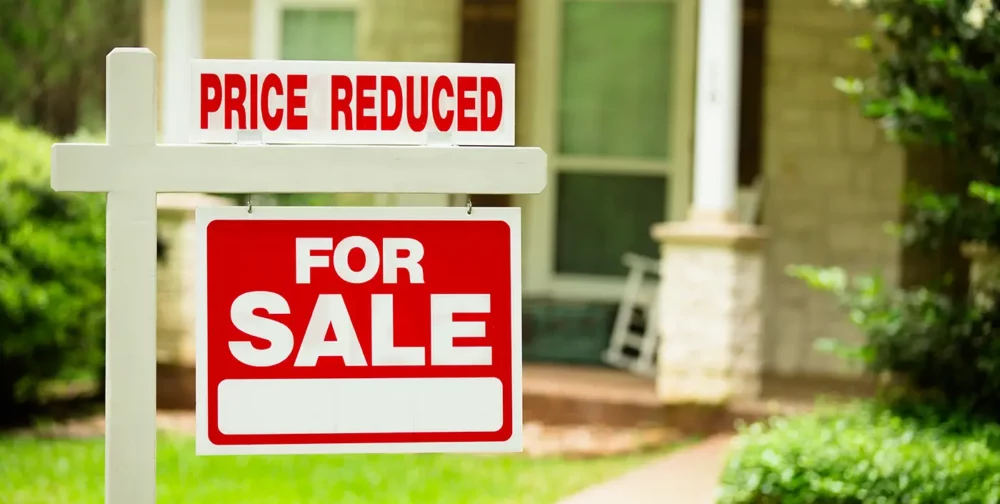Introduction
In the ever-evolving realm of real estate, the art of pricing plays a paramount role. As a potential buyer or seller, you might be wondering, what exactly are real estate price reductions? Why are they crucial? And how do they impact the market? Let’s delve into this captivating topic and unlock the secrets behind successful real estate transactions.

A. Definition and Importance of Real Estate Price Reductions
Real estate price reductions refer to the strategic adjustment of property prices to attract potential buyers or expedite the selling process. It is an essential element in the dynamic real estate market, where pricing can make or break a deal. By reducing the asking price, sellers create an opportunity for prospective buyers to perceive the property as more affordable and enticing, thus increasing the chances of a successful sale.
B. The Impact of Price Reductions on the Real Estate Market
Price reductions significantly influence the real estate market, shaping buyer behavior, inventory levels, and overall market dynamics. When properties undergo price reductions, they tend to garner increased attention from potential buyers. This surge in interest often leads to heightened competition and the potential for multiple offers. Moreover, price reductions can expedite the sales process, reducing the time a property spends on the market.
By embracing price reductions, sellers can avoid the risks associated with overpricing, such as stagnant listings and a lack of buyer interest. In a competitive market, where new listings are constantly emerging, pricing a property effectively is crucial to maintaining a competitive edge. Price reductions enable sellers to adapt to market conditions, attract serious buyers, and ultimately secure successful transactions.
Now that we understand the definition and importance of real estate price reductions, let’s explore the factors that influence these adjustments in Section
Factors Influencing Real Estate Price Reductions
A. Economic Factors Affecting Property Prices
In the realm of real estate, economic factors have a significant impact on property prices. Factors such as interest rates, inflation, and economic stability play a crucial role in determining the value of properties. When the economy experiences a downturn or undergoes fluctuations, sellers may opt for price reductions to align their property’s value with the prevailing economic conditions. By adjusting the price, sellers can attract potential buyers who are more cautious with their investment decisions during uncertain economic times.

B. Market Conditions and Demand-Supply Dynamics
Market conditions and the interplay between demand and supply greatly influence real estate price reductions. When the market is saturated with inventory and buyers have a wide array of choices, sellers may choose to reduce prices to stand out from the competition. Conversely, in a seller’s market where demand exceeds supply, sellers might not feel the need for price reductions as properties are more likely to attract multiple offers and sell quickly. Monitoring market conditions and understanding the demand-supply dynamics is essential in determining the necessity and extent of price reductions.
C. Seller’s Motivation and Urgency to Sell
The motivation and urgency of sellers can also contribute to real estate price reductions. Sellers who are in a hurry to sell due to personal circumstances such as relocation, financial constraints, or impending deadlines may be more inclined to reduce prices to expedite the selling process. Additionally, sellers who have been on the market for an extended period without receiving substantial offers may consider price reductions to reignite buyer interest and increase the likelihood of a successful sale.
D. Property Condition and Potential Renovation Costs
The condition of a property and the potential costs of renovations can influence the decision to reduce the listing price. Properties in need of repairs or cosmetic updates may not be as attractive to buyers, thus warranting a price adjustment. By factoring in the estimated renovation costs, sellers can strategically reduce the price to compensate for the additional investments the buyer might need to make. This approach ensures transparency and appeals to buyers who are seeking properties that align with their budget and desired condition.
Understanding the various factors that influence real estate price reductions enables sellers to make informed decisions. In the subsequent section, we will explore the benefits of implementing price reductions in real estate transactions.
Section III: Benefits of Real Estate Price Reductions
Real estate price reductions offer a myriad of advantages that can significantly impact the success of a property sale. By strategically adjusting the price, sellers can unlock a range of benefits that enhance buyer interest, expedite the sale process, and ensure a competitive edge in the market.
A. Increased Buyer Interest and Potential for Multiple Offers
When a property undergoes a price reduction, it immediately becomes more attractive to potential buyers. The lowered price point sparks curiosity and generates a sense of urgency among buyers who may have previously overlooked the property due to its initial pricing. This increased interest can lead to a higher volume of showings and inquiries, presenting a greater chance of receiving multiple offers.
B. Faster Sale and Reduced Time on the Market
One of the most notable benefits of real estate price reductions is the potential for a faster sale. By aligning the price with market expectations and buyer affordability, sellers can expedite the transaction process. Reduced listing prices often attract serious buyers who are actively searching for properties within their budget. This targeted approach minimizes the time a property spends on the market, reducing the risk of becoming stagnant and losing buyer interest.

C. Avoiding the Risk of Overpricing and Stagnant Listings
Overpricing a property can have detrimental effects, leading to extended listing periods and minimal buyer interest. Real estate price reductions help sellers avoid this risk by aligning the price with market conditions and buyer expectations. By accurately pricing the property from the start or promptly adjusting the price, sellers can prevent the property from languishing on the market and ensure a steady flow of potential buyers.
D. Maintaining a Competitive Edge in the Market
The real estate market is a dynamic and competitive landscape. With new listings constantly entering the market, maintaining a competitive edge is vital for sellers. Price reductions allow sellers to stay ahead by adapting to market conditions and remaining attractive to buyers. By positioning the property as a desirable and competitively priced option, sellers can attract serious buyers and increase the likelihood of a successful transaction.
In Section IV, we will explore effective strategies for implementing real estate price reductions to maximize their benefits.
Strategies for Effective Real Estate Price Reductions
To ensure successful real estate price reductions, it is crucial to employ strategic tactics that attract potential buyers while maintaining the property’s value. Let’s explore some effective strategies that can help you navigate the process smoothly.
A. Analyzing Market Data and Comparable Sales
Before implementing any price reduction, it’s important to conduct a thorough analysis of the current market. By assessing market data and researching comparable sales in your area, you can gain valuable insights into the pricing trends and competition. This information allows you to make informed decisions about the appropriate reduction amount and position your property competitively.
B. Setting Realistic Initial Listing Prices
One of the keys to a successful price reduction is setting a realistic initial listing price. Overpricing a property can deter potential buyers and result in a prolonged time on the market. By pricing your property competitively from the start, you can attract more interest and potentially avoid the need for significant reductions later on.
C. Monitoring Market Feedback and Adjusting Prices Accordingly
Once your property is listed, it’s essential to actively monitor market feedback and adjust prices accordingly. Engage with potential buyers and their agents to understand their perceptions and concerns. By staying responsive to market dynamics and adjusting prices in a timely manner, you can demonstrate flexibility and attract serious buyers.
D. Utilizing Marketing Techniques to Highlight Price Reductions
Effectively promoting your price reductions is vital to maximizing their impact. Utilize various marketing techniques to showcase the adjusted price and create a sense of urgency among potential buyers. This can include updating listing descriptions, utilizing social media platforms, and collaborating with real estate agents to reach a wider audience. By highlighting the value and benefits of the reduced price, you can capture the attention of motivated buyers.
Implementing these strategies will increase the likelihood of a successful real estate price reduction. However, it’s important to be mindful of the potential challenges and risks associated with these adjustments, which we’ll explore in Section
Section V: Potential Challenges and Risks of Real Estate Price Reductions
Navigating the realm of real estate price reductions is not without its challenges and risks. While these adjustments can be highly effective in attracting buyers and expediting sales, it is essential to be aware of potential pitfalls. Let’s explore some of the key challenges and risks associated with real estate price reductions.
A. Perception of Property Value and Quality
One of the primary challenges sellers face when reducing the price of a property is the perception of its value and quality. Buyers may question why a property’s price has been reduced and may perceive it as a sign of underlying issues or shortcomings. It is crucial for sellers to effectively communicate the reason for the price reduction, addressing any concerns and highlighting the value and quality of the property. Utilizing professional photography, virtual tours, and detailed property descriptions can help mitigate any negative perceptions and showcase the property’s true potential.

B. Potential Impact on Seller’s Profit Margin
Reducing the price of a property inevitably affects the seller’s profit margin. While the goal is to attract buyers and expedite the sale, it is vital to carefully consider the financial implications of the price reduction. Sellers must analyze their initial pricing strategy, market conditions, and urgency to sell to make informed decisions about reducing the price. Working closely with a real estate agent or professional can provide valuable insights and guidance to ensure a balanced approach that maximizes the chances of a successful sale while protecting the seller’s financial interests.
C. Balancing Price Reductions with Maintaining Property Value
Finding the delicate balance between price reductions and maintaining the perceived value of a property is a crucial aspect of the selling process. While reducing the price can attract buyers, it is essential not to undermine the property’s value or undercut its worth. Sellers must consider the current market conditions, comparable sales, and the property’s unique features to determine an appropriate price reduction strategy. By striking the right balance, sellers can position their property competitively while preserving its value and ensuring a successful sale.
As we’ve explored the potential challenges and risks associated with real estate price reductions, it is vital to understand effective strategies for implementing these adjustments. In Section IV, we will delve into various strategies to ensure successful and impactful price reductions.
Conclusion
In conclusion, real estate price reductions are a vital tool in the ever-changing world of property transactions. By strategically adjusting prices, sellers can attract more potential buyers, increase market interest, and expedite the sales process. These reductions play a crucial role in maintaining a competitive edge in the real estate market, allowing sellers to adapt to market conditions and avoid the pitfalls of overpricing.
Throughout this article, we have explored the definition and importance of real estate price reductions. We have seen how price adjustments impact the market by generating increased buyer interest, potential multiple offers, and reducing the time properties spend on the market. By implementing effective strategies for price reductions, sellers can maximize their chances of securing successful transactions and staying ahead in a competitive industry.
Remember, when it comes to real estate price reductions, it’s essential to analyze market data, set realistic initial listing prices, and be responsive to buyer feedback. By embracing price reductions as a strategic tool, sellers can navigate the market dynamics, maintain a competitive edge, and ultimately achieve their desired outcomes.
So, whether you’re a buyer or a seller, consider the power of price reductions in your real estate endeavors. Embrace this tool to unlock opportunities, captivate potential buyers, and pave the way for successful transactions. With careful planning and execution, you can navigate the real estate market with confidence and achieve your goals.





